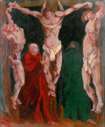 |
 |
The Last Supper |
|
 |
In these same years, the artist had
frequent contact with Giuseppe Gorgerino, he too from Turin and close to Piero Gobetti,
cultural editor of the newspaper L’Ambrosiano, which was one of the
"locations" par excellence of Milanese intellectual circles. The newspaper, for which Elio Vittorini, Guido Piovene, and Delio Tessa also
wrote, had as its art critic Carlo Carrą; Carrą’s substitute, Renato Birolli, also
worked as a proofreader, and for two or three months a year Sassu took his place in this
job. |
 |
 |
Crucifixion |
|
 |
An early example of Sassu’s
sacred art is the The Last Supper of 1929, in
which his aspirations toward the modern finds expression in the diners gathered around the
figure of Jesus, dressed according to the dictates of contemporary fashion, and in the
landscape that can be glimpsed behind the room, presenting an urban reality in full
development. The climate of the modernist debate is reflected also in the paintings shown
in 1932 at the Galleria del Milione: Il figliuol prodigo, Deposition, and I
figli di Isacco; on that same occasion Birolli presented San Zeno pescatore. A prodigious quantity of studies, drawings, and watercolors preceded the
creation of his first religious painting in the narrow sense, the Resurrezione that
in 1933 he would exhibit at the first Mostra del Sindacato Nazionale delle Belle Arti in
Florence, followed by the large Deposition now in the Vatican.
Religious themes - for example various versions of Crucifixion - were amply taken up again during the war years, characterized by a
distancing from traditional iconography: the figure of Christ represents a wholly earthly
suffering, and equally earthly, far from any form of spirituality, is the atmosphere
emanating from the series of Councils, beginning in 1944. |

